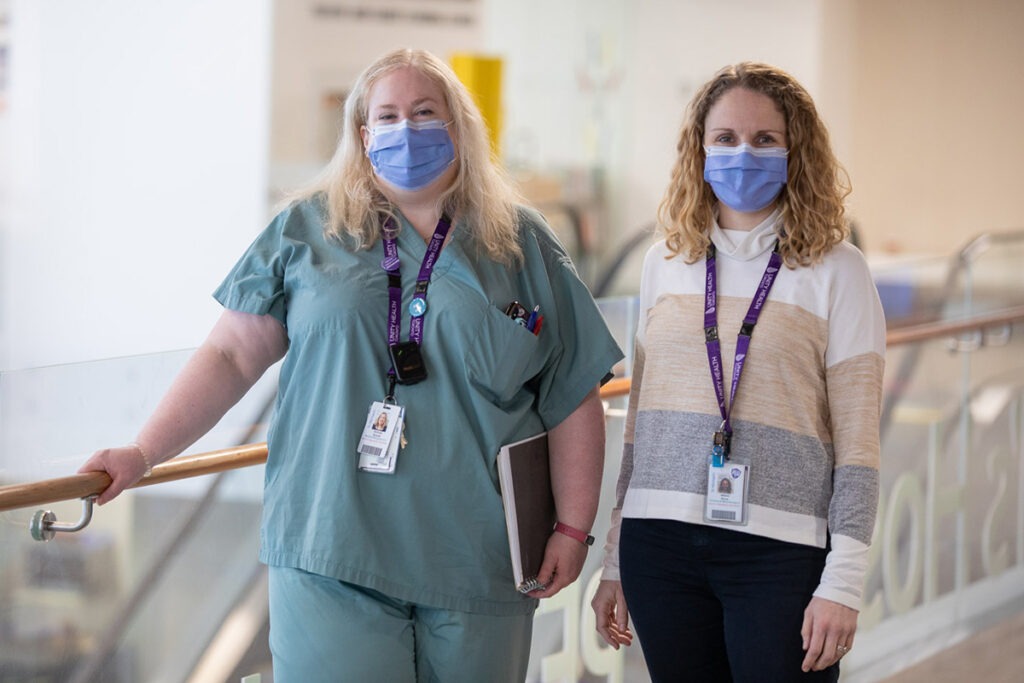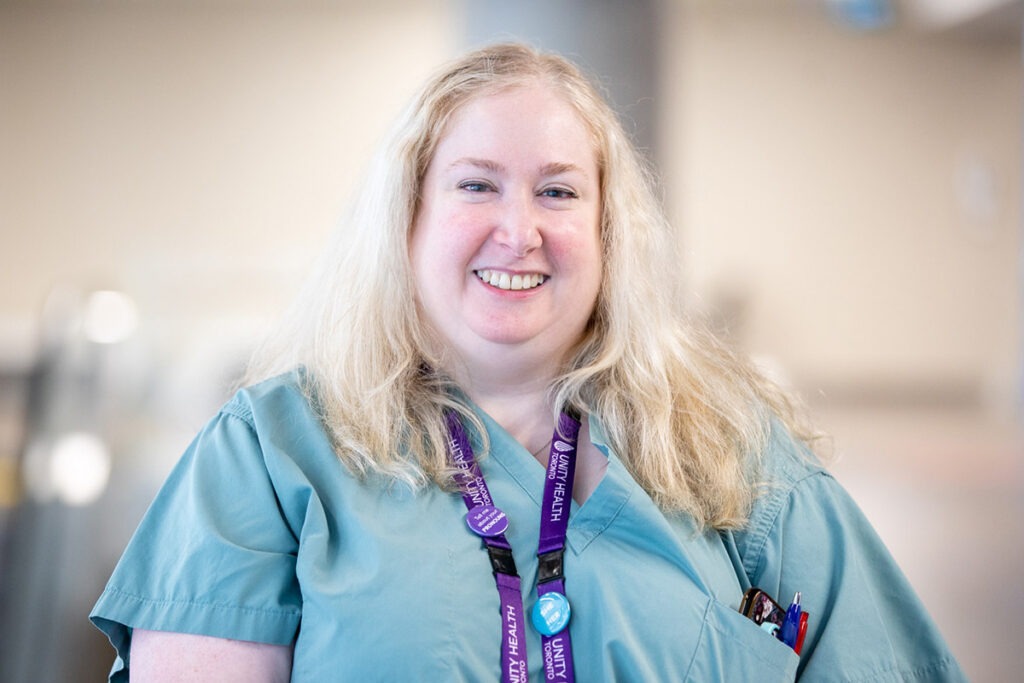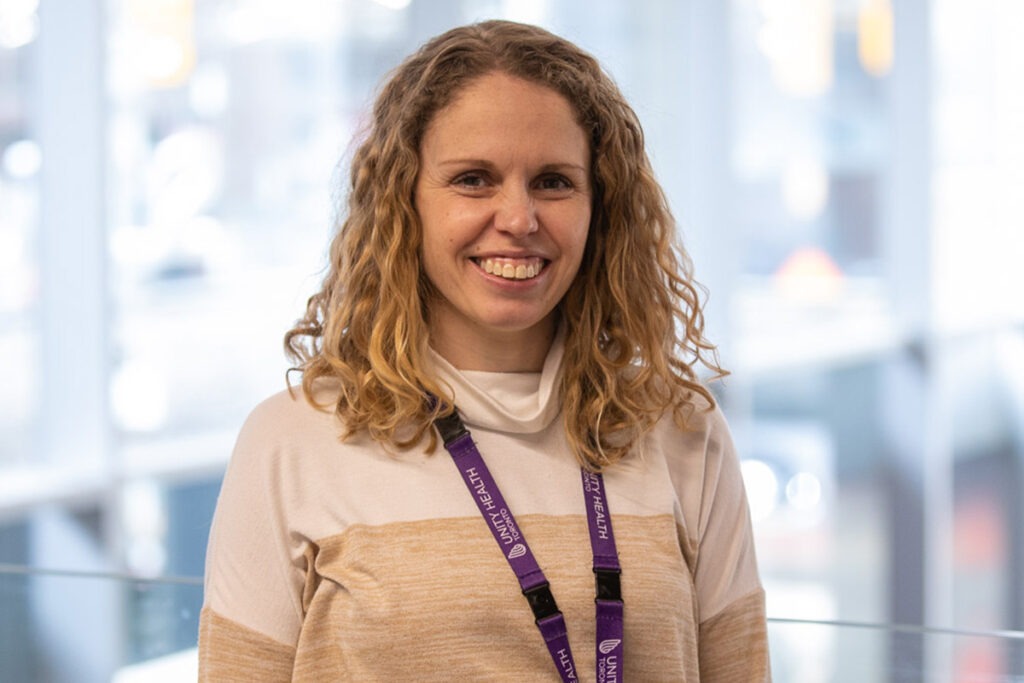You’re discharged from hospital, then what? Unity Health staff help patients navigate next steps

Leaving a hospital after a serious health event can be a daunting experience. Who will answer your questions? Will you get the support you need to recover?
This can be especially true for people who are homeless or under-housed or people leaving the hospital for a long-term care home. Will you be able to find a space to stay? Will the shelter staff or your new care team understand your medical needs?
The Medical Surgical Intensive Care Unit (MSICU) and the Trauma and Neurosurgery program at St. Michael’s Hospital has two new Care and Transitions Facilitator (CTF) roles to help patients navigate the complexities of the health care system during this uncertain time.
Dorinda Sinnott joined the MSICU in August as their first-ever CTF. She helps patients return to their local hospital once they complete specialized care at St. Michael’s. For patients who no longer need critical care, she often helps them transfer to a weaning program, complex continuing care, long term care or a shelter.
Allison Rinne has been with the Trauma and Neurosurgery program for seven years and moved into this new CTF role in April. She follows up with patients who are returning to the community after receiving trauma care at the hospital. In particular, she gives additional support to patients who were involved in a violent incident, patients who experience mental health or substance use disorders, patients who are insecurely housed or experiencing homelessness and patients who need home care.
These roles were created based on feedback from patients and families on St. Michael’s Hospital’s Patient and Family Council (PFC).
We spoke with Sinnott and Rinne about their role as CTFs, the support they provide and how they help to improve access to care, both at St. Michael’s and in the community.
What motivated you to become a Care and Transitions Facilitator and how does your past experience inform your work?

DS: When I first started at St. Michael’s in 2009, I was a social worker in the MSICU for about two years. Then I moved over to Patient Relations, where I worked for about 11 years.
I was excited to get back to frontline work and – with this new role on the unit – carve out what we can do to help improve the patient experience. On the Patient Relations team, I learned a lot about the patient experience – both good and bad. I think it’s really valuable to be mindful of what patients and families often reported as negative aspects of their care.
The need for improved communication with patients and families was a common issue so I try to bring that to my practice. I will explain to patients and families what the plan is and give them the opportunity to ask questions about next steps. I also let them know that I’m open to talk later and provide educational material and resources.
AR: I’m an occupational therapist (OT) by background, and I’ve worked in the Trauma and Neurosurgery program for seven years. I really love these populations. I think it’s a true privilege that I get to help our patients adjust to what is usually a life-changing experience or a long and complicated recovery.
As an OT, I often wondered what happened to our patients after they left the hospital. I worried that people would have trouble navigating the health system once they didn’t have access to our supports anymore. I was excited to hear that our program was investing in this role to offer more wraparound care to patients after they left the hospital.
Many of the patients you support are experiencing homelessness or are under-housed. Toronto’s shelter system is currently experiencing significant pressures, how has this environment impacted your perspective on the work you do?
DS: For me it’s challenging when someone wants to leave against medical advice and they don’t have a fixed address or home to go to. I will make calls to try to find them a shelter bed and, while I know that city staff and shelter providers are trying their best, sometimes we won’t have a great option for our patients. If they have a case worker, we call them to help the patient follow up on their medical recommendations. We get them warm clothing and a taxi chit along with their discharge instructions.
Without the support of me and my team, people might be going out into the elements with just the hospital gown on their back. I’m grateful that I’ve been able to help people – even if they are leaving sooner than we would advise – so that they are going as safely as possible.

AR: St. Joseph’s, St. Michael’s and Providence historically have all been committed to supporting vulnerable populations. It’s great to see that it’s a priority organizationally to care for and advocate on behalf of the homeless and under-housed.
We have a lot of really great initiatives – for example, the Navigator Project [a research project that aims to improve access to care for people experiencing homelessness] or the THRIVE program [a program for victims of violence that coordinates wraparound services after hospital discharge]. They tend to develop into bigger ideas and advocacy efforts. That’s really promising and hopefully roles like Dorinda’s and mine will also contribute.
Have there been any situations or experiences that stick out in your mind, where you felt you had made a positive impact in your role?
DS: One experience that stands out is a patients who had been injured while visiting from out of province. It was a learning opportunity for me on how the process works when a patient needs to go home and they live outside of Ontario. I was able to coordinate with the patient’s local hospital, investigate transportation options and provide education to the family on how health insurance would work in their situation. It was very satisfying when this patient was able to return home to and be closer to their loved ones while they continued their care journey.
AR: One of the interesting types of patients for me, that I didn’t anticipate going into this role, is trauma patients who are discharged from the emergency department (ED). I might call someone after a car accident who, medically-speaking, is doing fairly well but needs help being connected to primary care.
We also catch a lot of people that are struggling and need psycho-social supports. We are fortunate to have services to link them to. We have a cutting-edge, nurse practitioner-run trauma clinic. There’s access to a social worker in that clinic and psychiatric supports. It’s a nice way that our team can work together to provide wraparound support in the ED.
What have been some of your key learnings or takeaways since starting in this role?
AR: First, it affirmed that we do a really good job as an inpatient team at care planning for our patients.
The other big learning I had was: you can’t navigate patients to services that don’t exist. Beyond Unity Health – across the system – we need to continue to advocate for the best way to support people. When people leave the hospital with nowhere to go or no services to support them, they frequently come back because that’s not the optimal recovery environment.
DS: For me, the biggest learning is how complex the system is, and how each step relies on something else to happen. For someone to get care in our unit, there needs to be a bed for them. For that bed to be available, someone else has to leave that bed. For them to leave, they need to have somewhere to go, there has to be a way to transport them there and staff and resources need to be in place once they arrive.
Everything we’re doing with this role is to make the discharge process run smoother and more efficiently for everyone. It benefits not just the patient currently in our unit, but also the critically ill patient in the emergency department or another hospital who needs the specialized care we provide.
AR: It’s also a shout out for all the support services staff that make things happen – the administrative and clerical staff who book the transportation, the environmental services staff who clean the room, the engineering and IT teams who make sure all the right equipment is there and working, and so on. There are all these pieces to how a patient gets cared for and gets to their next place.
DS: I totally agree. So much needs to happen for patients to access clinical services. It’s amazing to see how the whole team, including non-clinical staff, works together to support patients.
